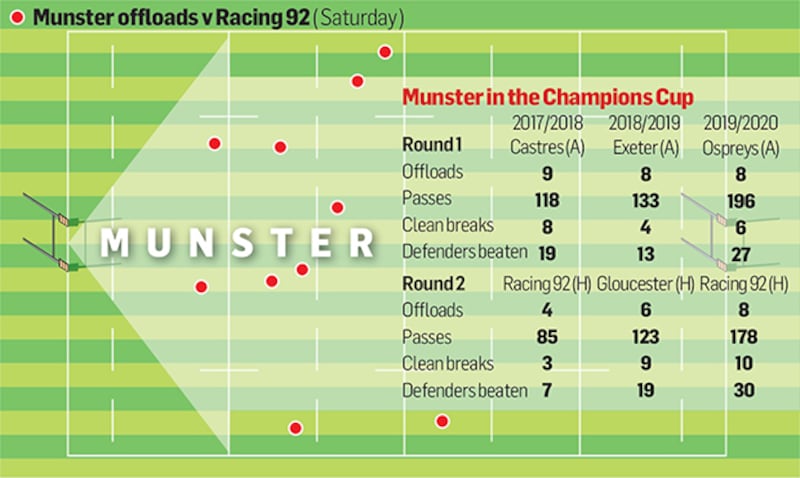So what is the Larkham effect and is it measurable?
The impact of former Australian international outhalf and backs' coach Stephen Larkham at Munster this season, a campaign that is still in its infancy in terms of the Pro 14 and the Champions Cup, has set tongues wagging about the influence that he has had on the team's attacking patterns.
A consensus in anecdotal evidence amongst pundits is that the province is sustaining greater width and fluency in terms of their patterns in possession, looking to explore the wider channels, relying more on a passing game and looking to offload with greater regularity.
There is statistical evidence to support these assertions, but, as is often the case, there is some mitigation to the argument provided in specific figures during the timeframe.
Johann van Graan took over as Munster coach in November 2017, we can look at attacking patterns over a three-season period in rounds one and two of the Champions Cup.
Felix Jones, part of coaching team under Rassie Erasmus for South Africa's World Cup triumph in Japan, was backs' coach for the first two seasons, while Larkham succeeded him for the present campaign.
Teams tend to evolve in style terms, while personnel also change. This offers the opportunity to alter the playing orientation, but visually Munster look to be more fluent.
There are two categories: “passes” – there has to be a knock-on effect in terms of the outcome rather than just the quantity to gauge progress – and “defenders beaten”, in which the figures have enjoyed a spectacular rise.
Possession
Over the past three seasons on the opening weekend of the Champions Cup, Munster have played away from home before returning to Thomond Park for the second set of fixtures. Ostensibly the easiest point of comparison is the two matches against Racing 92 last Saturday and in 2017. The number of “passes” jumped from 85 to 178, and in terms of “defenders beaten” from seven to 30.
One important parameter to note in providing some context is that in Munster’s 14-7 win over Racing in 2017, they enjoyed only 43 per cent possession whereas last weekend in a 21-21 draw they had a whopping 64 per cent of the ball.
Larkham’s influence is appreciable nevertheless, especially taking into account the two European games to date this season, the other is Munster’s 32-13 four-try, bonus point win over the Ospreys in the Liberty stadium a fortnight ago. With 55 per cent possession, the Irish province racked up 196 “passes” and 27 “defenders beaten”, albeit against a significantly depleted Welsh side.

In the two previous seasons they drew 17-17 (53 per cent possession) against a Castres Olympique side that went on to win the French Top 14, and last year a 10-10 draw (47 per cent possession) against the Exeter Chiefs – they would finish runners-up in the English Premiership – at Sandy Park.
Lineout variations
The attacking rhythm of Munster’s performances has altered this season across many areas, conspicuously in the expansion of lineout variations that have been very effective.
There has also been a recalibration from an individual perspective is terms of where players pop up, and a change in habits in some cases. No 8 CJ Stander’s brace of offloads last weekend was heavily referenced, along with his typically massive work rate.
On the subject of "offloads", it is one area that has not changed as much as other categories over the period examined. Munster threw 10 against Racing 92, three of which belonged to left-wing Keith Earls; the only player to offload inside the Munster half. Two were thrown inside the French side's 22, the rest between that mark and the halfway line.
JJ Hanrahan enjoyed a superb game at outhalf, taking the ball to the line and varying the point of attack, while his range of passing was excellent. He will benefit hugely from Larkham's presence, the 45-year-old an outstanding talent and gig game performer with a laid back style. Tyler Bleyendaal and Joey Carbery have also expressed their delight at his presence.
Skill level
For his part, Larkham’s pretty content with the raw material, as he pointed out recently.
"I think the talent, the skill level over here is probably better than it is in Australia. Honestly, I was very impressed with the skill levels of these players. Their skill levels are good and their ability to learn things is definitely better than some Australian players."
Yet for all the incremental improvement and shift in emphasis when it comes to the attacking patterns, one figure that stood out from last week’s Racing match was the fact that Munster conceded just three penalties in 80 minutes; this from a team that had been running at double last season’s tally at this point in the season.
Larkham referenced the need for an improvement ahead of the Racing match, and the players responded – much as they appear to have done in terms of everything he has brought to the province.
















